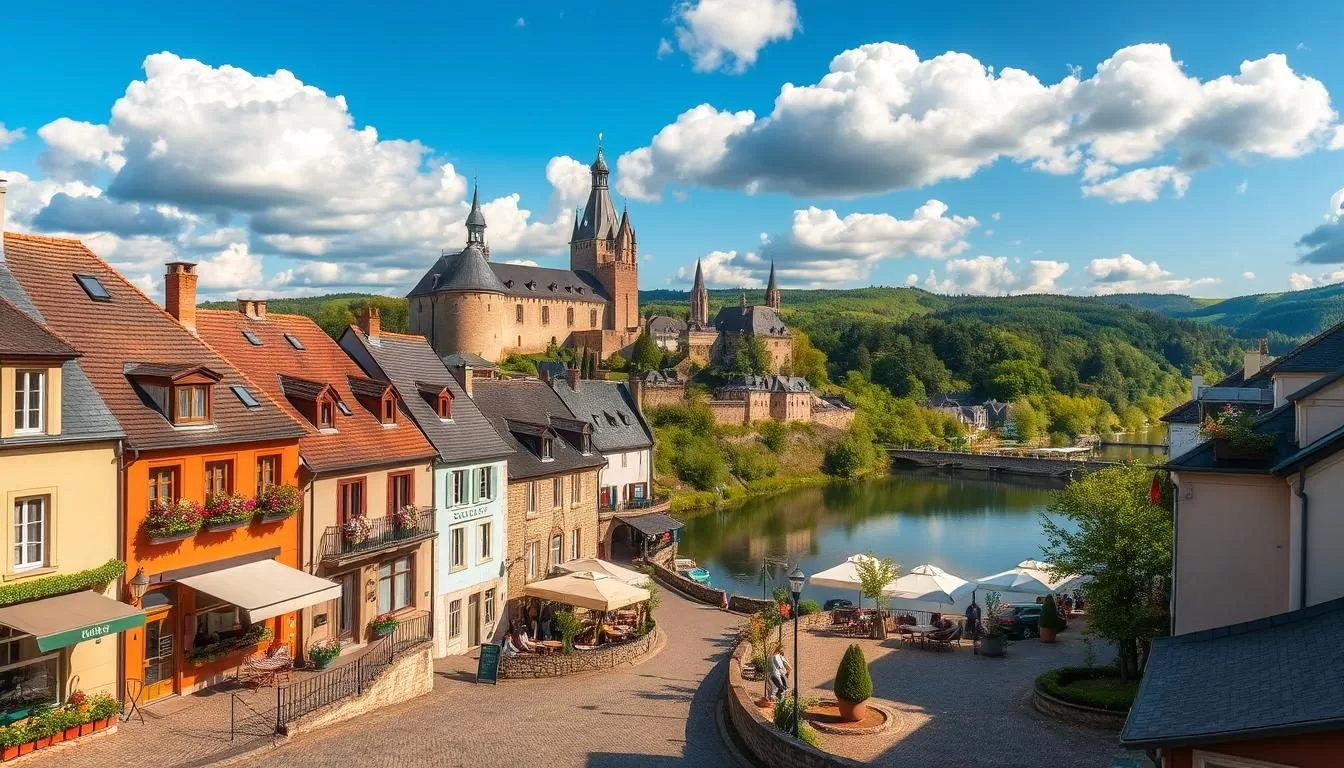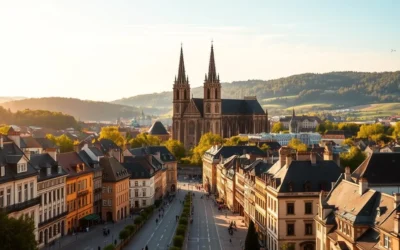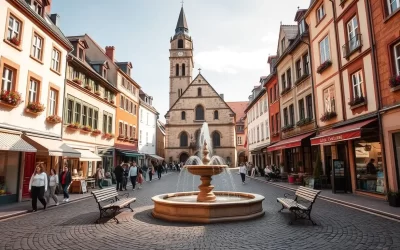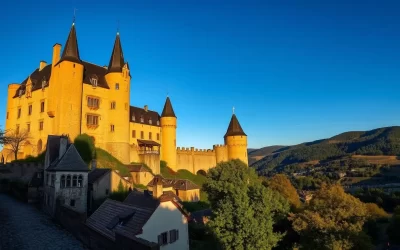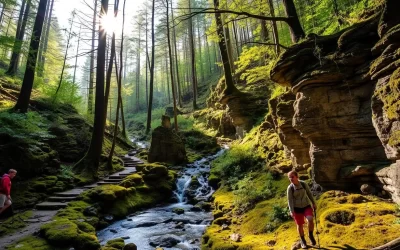Discover the charm of Wiltz, a hidden gem nestled in the heart of Luxembourg’s beautiful Ardennes region. This enchanting town offers a perfect blend of history, culture, and natural beauty, making it an ideal destination for travelers.
As you explore Wiltz, you’ll uncover its rich heritage, from the impressive Renaissance castle to peaceful gardens and meaningful monuments. The town’s unique layout, with an upper town featuring the castle on a plateau and a lower town in the river valley, adds to its allure.
Whether you’re a history buff, nature lover, or cultural enthusiast, Wiltz has something special for you. This comprehensive guide will help you plan your visit to this captivating destination.
Discovering the Historic Town of Wiltz
As you explore Wiltz, you’ll uncover the layers of its rich history that have shaped this charming town in the Grand Duchy of Luxembourg, nestled in the heart of Europe. The town’s history is a complex tapestry woven from its strategic location in the Ardennes, making it significant throughout various historical periods, from medieval times to the World Wars.
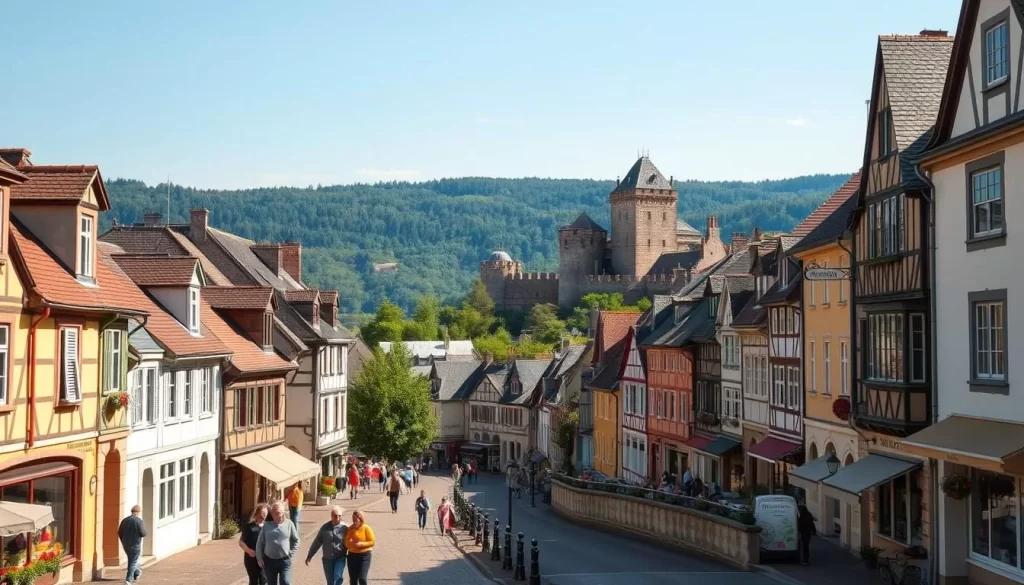
Wiltz’s history took a dramatic turn during World War II when it was occupied by Nazi forces from May 1940 until its liberation by American troops in January 1945. This period deeply marked the town’s identity and is a crucial part of its story. The citizens of Wiltz showed remarkable resilience and bravery, particularly during the general strike in August 1942 against enforced conscription into the German army, which began at the Ideal leather factory.
A Brief History of the Ardennes Gem
The strike was a significant act of resistance, but it came at a great cost. Twenty Luxembourgers, including four teachers, were executed, 27 families were deported, and over 200 young people were forcibly recruited into the Wehrmacht. The Battle of the Bulge further devastated Wiltz, destroying approximately 80% of its homes. Today, this painful part of Wiltz’s history is commemorated through various monuments and museums that you can visit to understand the town’s resilient spirit.
- The town’s strategic location made it a significant site throughout history.
- Wiltz was occupied by Nazi forces during World War II, a period that deeply affected its identity.
- The general strike in August 1942 was a brave act of resistance against the Nazi occupation.
- The town suffered greatly, with executions, deportations, and forced conscriptions.
- The Battle of the Bulge destroyed a significant portion of Wiltz’s homes.
- Today, Wiltz’s history is preserved through monuments and museums.
By visiting these sites, you’ll gain a deeper understanding of Wiltz’s rich history and its significance as a town in the Grand Duchy of Luxembourg, nestled in the heart of Europe.
Exploring Wiltz Castle and Its Museums

As you step into the heart of Wiltz, Luxembourg, the majestic Wiltz Castle awaits, embodying the essence of the region’s rich history. This magnificent Renaissance structure is not only the town’s crown jewel but also offers breathtaking views of the surrounding landscape.
The Renaissance Castle’s Rich History
The castle’s history dates back to the 12th century when the Counts of Wiltz, among Luxembourg’s oldest noble families, began building their residence on a rocky promontory in OberWiltz. Over the centuries, the castle faced numerous challenges, including being burned by French besiegers in 1388 and destroyed by Philip of Burgundy in 1453.
The oldest surviving part of the castle is the Witches Tower from 1573, featuring a statue of Count Jan (John VI), the legendary armored knight considered Wiltz’s guardian. The construction of the current Renaissance castle began in 1631 under Count Jan but wasn’t completed until 1720 due to famine and war, with the monumental garden staircase finished in 1727.
Today, the castle houses several fascinating museums that you can explore, including the National Museum of Brewing, the Tannery Museum, and the Battle of the Bulge Museum. Each museum offers a unique window into different aspects of Wiltz’s cultural heritage and historical significance within the Grand Duchy of Luxembourg, showcasing the history and beauty of the region.
Visiting Wiltz Castle and its museums is a journey through time, allowing you to appreciate the rich history and architectural beauty of this Luxembourg gem. As you explore the castle and its surroundings, you’ll discover why it remains a cherished landmark in the region.
Wiltz, Luxembourg: Best Things to Do – Top Picks for History Buffs
History buffs will find Wiltz to be a captivating destination, rich in historical significance and memorable experiences. As you explore this charming town, you’ll discover a plethora of historical landmarks and monuments that bring the past to life.
National Strike Monument
The National Strike Monument is a poignant tribute to those who lost their lives during the 1942 general strike against Nazi occupation. This striking monument, shaped like a lighthouse, is adorned with powerful stone sculptures created by Lucien Wercollier. The sculptures depict the biblical story of David and Goliath, symbolizing Luxembourg’s resistance against the Nazi regime.
Each year on August 31st, a memorial service is held at the monument to honor those who sacrificed their lives. The town’s designation as a “Martyr Town” reflects the tremendous suffering its citizens endured during the Battle of the Bulge and throughout World War II.
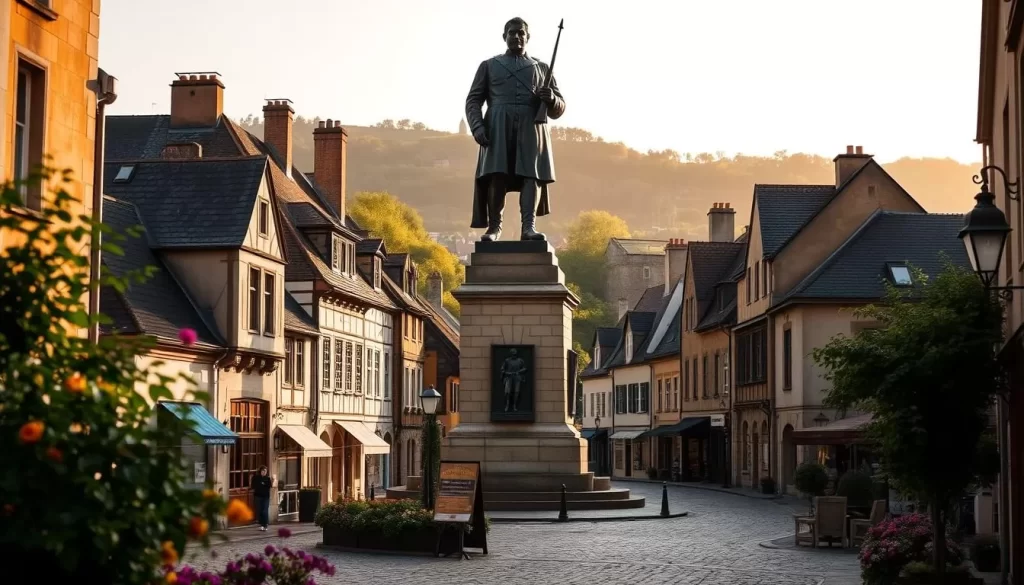
Wiltz offers many places of historical significance that will transport you back in time. You’ll find an authentic Sherman tank (M4-A3 series) parked in the town’s main square, which was used by US forces during the liberation of Wiltz. This tank, weighing an impressive 31.6 tons, serves as a reminder of the town’s role in World War II.
| Historical Landmark | Description |
|---|---|
| National Strike Monument | A lighthouse-shaped monument commemorating the 1942 general strike against Nazi occupation. |
| Sherman Tank | An M4-A3 series tank used by US forces during the liberation of Wiltz, weighing 31.6 tons. |
| Stone Sculptures | Created by Lucien Wercollier, these sculptures depict the biblical story of David and Goliath, symbolizing Luxembourg’s resistance. |
As you explore Wiltz, you’ll find that the town’s history is palpable, with many monuments and artifacts preserving the memory of its resistance and resilience during one of history’s darkest periods.
Natural Beauty and Gardens in Wiltz
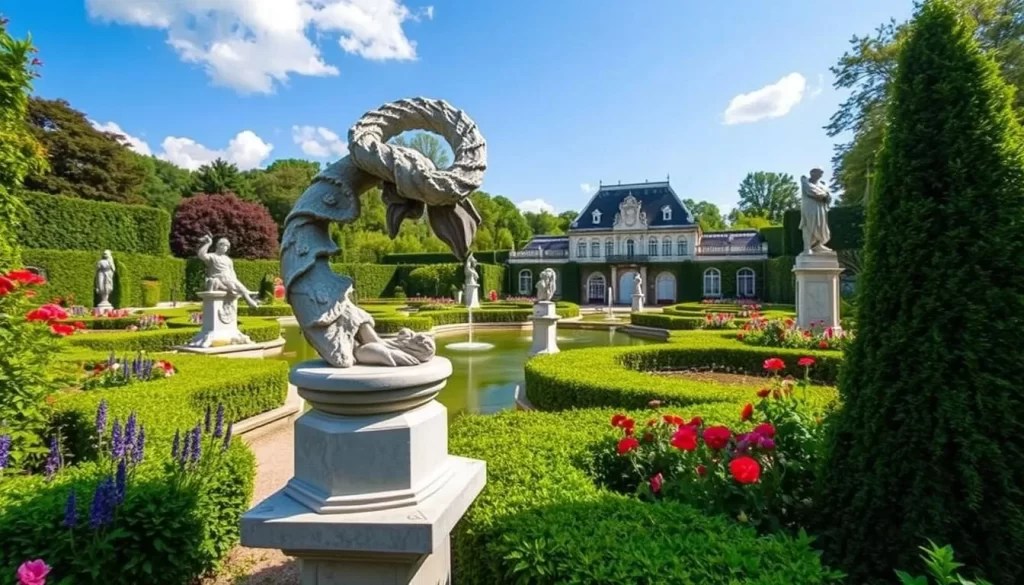
As you explore Wiltz, you’ll discover that its natural beauty is just as compelling as its rich history. The town is home to several gardens and natural attractions that offer a refreshing contrast to its historical sites.
The Jardin de Wiltz: A Living Art Garden
The Jardin de Wiltz is a 2.5 hectare public garden designed as a form of living art. Created and maintained by a diverse group including artists, craftsmen, people with disabilities, and the long-term unemployed, it was founded in 1983 by “Der Blaue Kompressor.” This unique garden is open year-round, featuring sculptures integrated among its foliage.
You’ll be enchanted by the natural beauty that surrounds Wiltz, offering a refreshing contrast to the town’s historical attractions. The Jardin de Wiltz stands out as a unique spot in the area, covering 2.5 hectares of thoughtfully designed public garden space that functions as a form of living art.
Some of the key highlights of the Jardin de Wiltz include:
– You’ll find this garden particularly special because it was created and is maintained by a diverse group including artists, craftsmen, people with disabilities, and the long-term unemployed.
– Founded in 1983 by the artistic collective “Der Blaue Kompressor,” the garden represents a beautiful blend of social inclusion and environmental aesthetics.
– The garden remains open year-round, allowing visitors to experience its changing beauty through all seasons, even in winter when it takes on a serene, frost-kissed appearance.
– As you wander through the garden, you’ll discover various sculptures integrated among the foliage, creating a harmonious dialogue between art and nature.
– This living art installation offers one of the most peaceful and contemplative experiences in Wiltz, making it a must-visit for nature lovers and art enthusiasts alike.
In the area around Wiltz, you’ll find that the natural attractions complement the town’s historical significance perfectly, making Wiltz a well-rounded destination for any traveler.
Religious and Cultural Sites
As you wander through Wiltz, you’ll discover a variety of religious sites that showcase its cultural heritage. The town is steeped in history, and its religious landmarks are a testament to its rich past.
Decanal Church of Saints Peter and Paul
The Decanal Church, dedicated to Saints Peter and Paul, dates back to the Middle Ages. This historic church is one of the town’s most significant religious landmarks. The tower, the oldest part of the structure, is where you’ll find the graves of the Counts of Wiltz, connecting the site to the town’s noble history.
In the church grounds, you’ll find the Plague Cross, erected in 1635, a poignant reminder of the devastating impact of the plague on Wiltz. The town was severely affected, with the number of families dwindling from 65 in 1623 to just 17 by 1659. The cross, though worn by time, remains a powerful symbol of the town’s resilience.
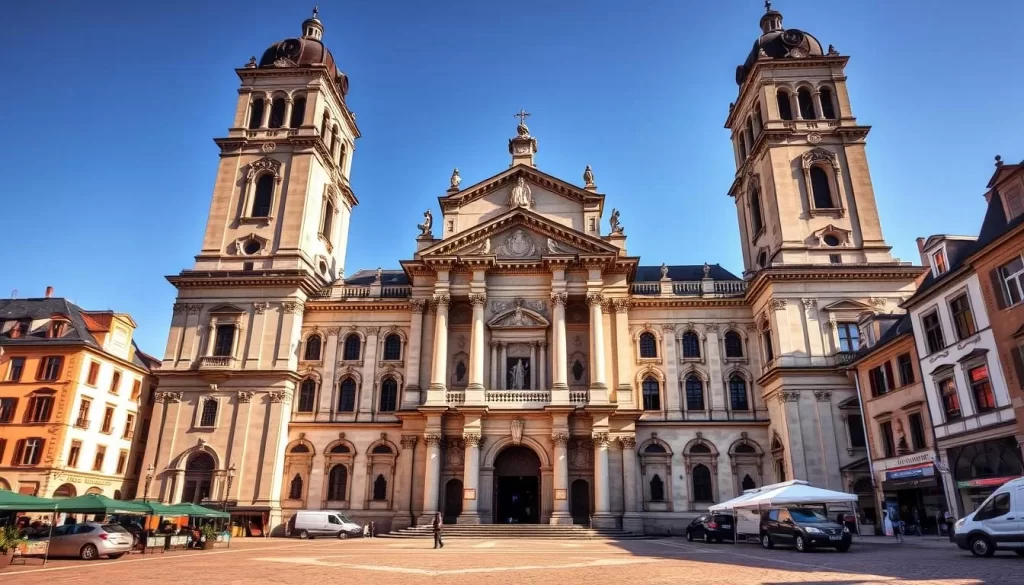
| Landmark | Year Established | Significance |
|---|---|---|
| Decanal Church of Saints Peter and Paul | Middle Ages | Important religious landmark, houses graves of Counts of Wiltz |
| Plague Cross | 1635 | Commemorates victims of the plague |
Wiltz’s religious sites not only serve as places of worship but also as cultural monuments that preserve the town’s history. Visiting these sites takes you back in time to earlier centuries, offering a unique glimpse into the town’s spiritual heritage and its ability to endure through challenging times.
Parks and Monuments Worth Visiting
Wiltz’s parks and monuments are a testament to its cultural and historical significance, making them a must-visit. As you explore this charming town, you’ll find that its green spaces and memorials offer a unique blend of natural beauty and culture.
The Significance of Simon Park and the Rodange-Renert Memorial
Simon Park, a tranquil oasis in the heart of Wiltz, has been a part of the town for approximately 150 years. This historic park is home to the Rodange-Renert Memorial, dedicated to the national poet Michel Rodange, who penned his famous work “Renert” while residing in Wiltz. The memorial is an innovative attraction that takes visitors on a circular tour past four distinct sections, featuring sculptures and water elements that highlight stanzas from Rodange’s epic poem.

The Rodange-Renert Memorial is not the only significant monument in Wiltz. The One Penny Monument, commemorating Lord Robert Baden-Powell, the founder of the scouting movement, is another spot worth visiting. This monument’s unique name stems from its funding by penny contributions from boy and girl scouts. It features three scout figures leaning back-to-back, symbolizing the virtues of service, help, and obedience.
Wiltz has established itself as a leading international scout center, with facilities that include eight chalets and eight tent sites. These accommodations welcome scout troops from around the world, contributing to the town’s vibrant atmosphere and international character. When you visit Wiltz, you’ll discover that its parks and monuments offer visitors something special, combining natural beauty with cultural significance.
- Simon Park provides a peaceful green space where you can relax and connect with local literary heritage.
- The Rodange-Renert Memorial is a unique cultural attraction that showcases the town’s rich literary history.
- The One Penny Monument is a significant historical landmark that commemorates the scouting movement’s founder.
- Wiltz’s facilities make it an ideal destination for international scout troops, enhancing the town’s youthful energy.
Hiking and Cycling Trails Around Wiltz

Discover the charm of Wiltz through its various trails, each offering a unique perspective on the town’s heritage and landscape. You’ll find that exploring Wiltz on foot or by bicycle is one of the best activities to experience the town’s rich heritage and natural beauty.
Cultural Walking Trails in Town
Wiltz features two cultural trails that allow you to delve into its history. The 3km Yellow Trail takes you through the upper town, with 21 informative panels explaining how Wiltz earned its title of “Cité de Martyre” (Martyr Town), while offering beautiful views of the surrounding landscape.
The trail is accessible for families with strollers via an alternative pathway on rue de la Montagne. The Red Trail, approximately 4.5km, offers a more extensive journey, taking you down to the Nieder-Wiltz bridge and up to the sanctuary of Our Lady of Fatima, past historical landmarks including Luxembourg’s last windmill.
For a more somber but historically significant experience, you can follow the Schumanns Eck remembrance trail. This poignant spot marks where American and German soldiers fought in freezing conditions during some of Luxembourg’s deadliest combat.
Cycling enthusiasts will appreciate the dedicated paths that connect Wiltz to surrounding villages and natural areas, offering a different perspective on the region’s landscape and cultural heritage. These trails combine physical activity with cultural and historical education, making them a perfect way to connect with Wiltz’s past while enjoying its present-day charm.
Annual Events and Festivals
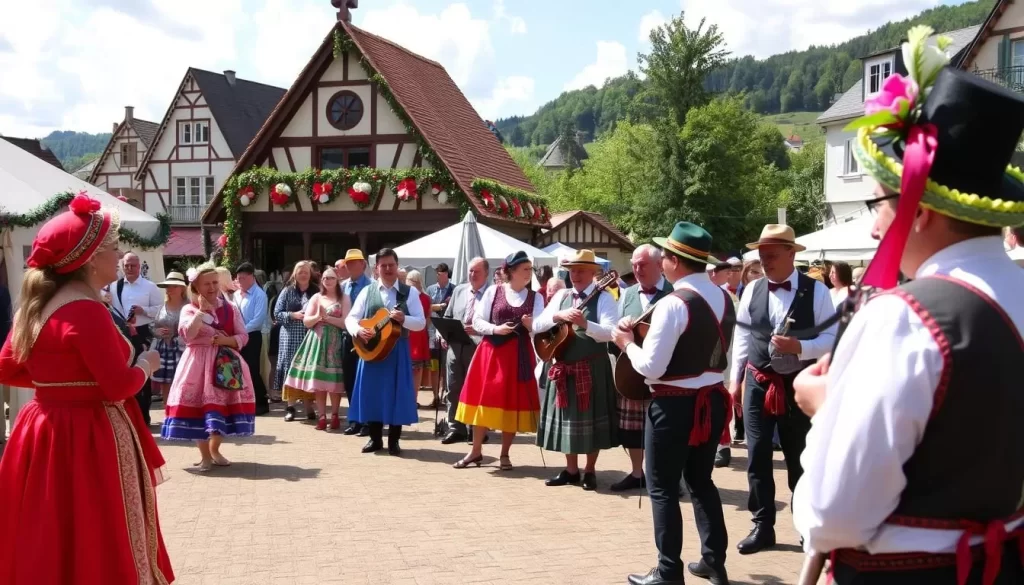
Experience the best of Wiltz’s culture and community spirit through its numerous annual events and festivals. Wiltz comes alive throughout the year with various events that showcase the town’s vibrant culture and community spirit.
The Wiltz Festival
The Wiltz Festival, established in 1953, is the crown jewel of the town’s cultural calendar. It transforms the castle and its 600 acres of lawns and gardens into a world-class performance venue, hosting international classical, rock, and jazz music acts during June and July. This prestigious festival brings a unique experience to this picturesque spot in the Ardennes.
The castle provides a magnificent backdrop for these performances, creating a magical atmosphere that enhances the musical experience for visitors from around the world. Beyond the main Wiltz Festival, the town hosts commemorative events throughout the year, particularly those honoring the resistance during World War II and the liberation of the town.
These events not only provide entertainment but also serve as important reminders of Wiltz’s historical significance and resilient spirit. By participating in these festivals and events, you can interact with locals and experience authentic Luxembourg traditions, making your visit to Wiltz more meaningful and memorable.
The variety of activities offered during these events ensures there’s something for everyone, from music lovers to history enthusiasts and families looking for engaging cultural experiences. Whether you’re interested in history, music, or simply enjoying the beautiful surroundings, Wiltz has something to offer.
Where to Stay and Dine in Wiltz
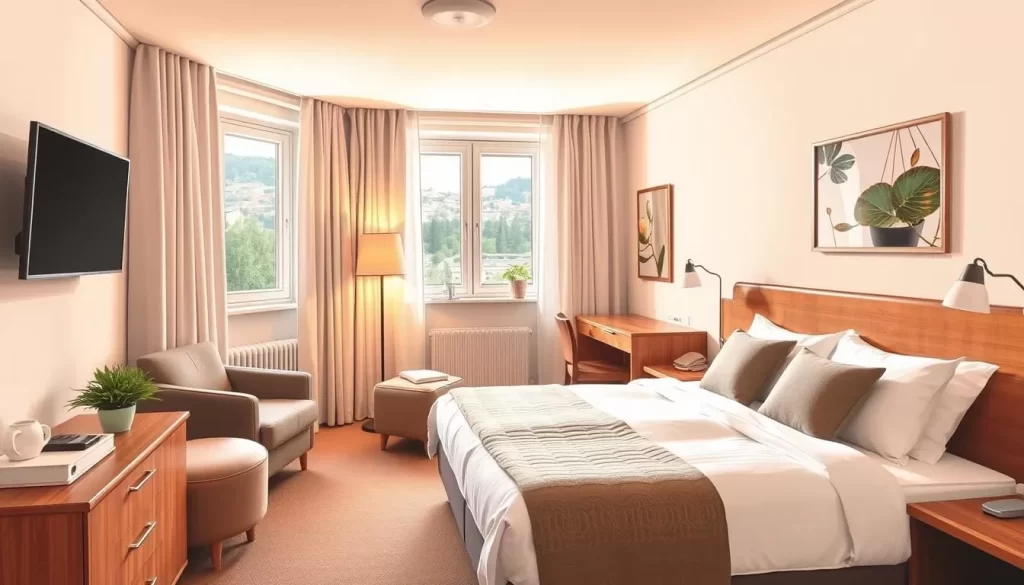
The charming town of Wiltz is home to various accommodations and eateries, providing a delightful experience for travelers. You’ll find many places to stay and dine that cater to different preferences and budgets, ensuring a comfortable experience during your visit.
Accommodation Options
Aux Tanneries de Wiltz offers comprehensive accommodations with singles, doubles, and family rooms, plus amenities like Wi-Fi, an indoor pool, sauna, and hammam, along with a highly recommended restaurant. If you prefer staying in the heart of town, Hotel-Restaurant Beim Schlass on Grand Rue provides comfortable rooms, free Wi-Fi and parking, and the convenience of bike rentals for exploring the surrounding area.
Families will appreciate the flexible accommodation options, including rooms with sofa beds and a spacious apartment with four large double bedrooms for larger groups. This makes it an ideal choice for families or groups of travelers.
When it comes to dining, you’ll discover a range of options to suit your taste. Café a Tasquinha serves authentic Portuguese specialties, including the traditional salt cod dish bacalao. For pizza, visitors recommend La Fourchette Dorée, which comes highly recommended for its delicious Italian dishes.
One of the most unique dining experiences in Wiltz is at Restaurant Eis Kichen, an inclusive, non-profit establishment housed in the former Gruber brewery buildings. It offers three main dishes: a traditional Luxembourgish option (“Le Tradi”), a vegan choice (“Geméising”), and an international classic (“Dal Mondo”), allowing you to sample local cuisine while supporting an admirable social enterprise.
Conclusion: Why Wiltz Deserves a Spot on Your Luxembourg Itinerary
Wiltz, nestled in the heart of Luxembourg’s Ardennes, offers a unique blend of history, culture, and natural beauty that makes it a must-visit destination. This charming town provides a perfect balance of rich history and cultural heritage, making it stand out among the many destinations in Luxembourg.
From the impressive Renaissance castle that houses multiple museums to the moving monuments commemorating the Battle of the Bulge, Wiltz takes you back in time while maintaining its contemporary appeal. Whether you’re admiring the panoramic views from the castle or exploring the Notre Dame church, Wiltz offers diverse activities that appeal to all interests.
As part of your broader exploration of the Grand Duchy, Wiltz provides a meaningful contrast that enriches your understanding of Luxembourg’s multifaceted character. With its wine bars, winter markets, and cultural events like the Wiltz Festival, this town is a destination that deserves a spot on your Luxembourg itinerary.
The above is subject to change.
Check back often to TRAVEL.COM for the latest travel tips and deals.
